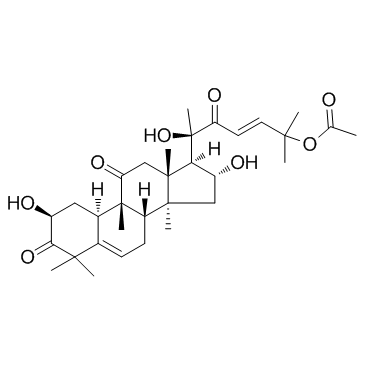6199-67-3
| Name | cucurbitacin B |
|---|---|
| Synonyms |
19-Nor-9β,10α-lanosta-5,23-diene-3,11,22-trione, 2β,16α,20,25-tetrahydroxy-9-methyl-, 25-acetate
(2S,4R,9β,16α,23E)-2,16,20-Trihydroxy-9,10,14-trimethyl-1,11,22-trioxo-4,9-cyclo-9,10-secocholesta-5,23-dien-25-yl acetate (2b,9b,10a,16a,23E)-25-(Acetyloxy)-2,16,20-trihydroxy-9-methyl-19-norlanosta-5,23-diene-3,11,22-trione 1,2-Dihydro-a-elaterin 19-Norlanosta-5,23-diene-3,11,22-trione, 25-(acetyloxy)-2,16,20-trihydroxy-9-methyl-, (2β,9β,10α,16α,23E)- Cucurbitacin B hydrate 19-nor-9β,10α-Lanosta-5,23-diene-3,11,22-trione, 9-methyl-2β,16α,20,25-tetrahydroxy-, 25-acetate Estr-5-ene-3,11-dione, 17-[(1R,3E)-5-(acetyloxy)-1-hydroxy-1,5-dimethyl-2-oxo-3-hexen-1-yl]-2,16-dihydroxy-4,4,9,14-tetramethyl-, (2β,9β,10α,16α,17β)- 1,2-Dihydro-α-elaterin [(E,6R)-6-[(2S,8S,9R,10R,13R,14S,16R,17R)-2,16-dihydroxy-4,4,9,13,14-pentamethyl-3,11-dioxo-2,7,8,10,12,15,16,17-octahydro-1H-cyclopenta[a]phenanthren-17-yl]-6-hydroxy-2-methyl-5-oxohept-3-en-2-yl] acetate 25-(Acetyloxy)-2b,16a,20-trihydroxy-9b-methyl-19-nor-10a-lanosta-5,23E-diene-3,11,22-trione |
| Description | Cucurbitacin B belongs to a class of highly oxidized tetracyclic triterpenoids; could repress cancer cell progression.IC50 value:Target: anticancer natural compoundin vitro: Cucurbitacin-B inhibited growth and modulated expression of cell-cycle regulators in SHSY5Y cells. At the molecular level, we found that Cucurbitacin-B inhibited AKT signaling activation through up-regulation of PTEN [1]. CuB induced apoptosis of A549 cells in a -concentration-dependent manner, as determined by fluorescence microscopy, flow cytometry and transmission electron microscopy. CuB dose-dependently inhibited lung cancer cell proliferation, with cell cycle inhibition and cyclin B1 downregulation. Apoptosis induced by CuB was shown to be associated with cytochrome c release, B-cell lymphoma 2 downregulation and signal transducer and activator of transcription 3 pathway inhibition [2]. CuB inhibited ITGA6 and ITGB4 (integrin α6 and integrin β4), which are overexpressed in breast cancer. Furthermore, CuB also induced the expression of major ITGB1and ITGB3, which are known to cause integrin-mediated cell death [3]. Cuc B treatment caused DNA double-strand breaks (DSBs) without affecting the signal transducer and activator of transcription 3 (STAT3), the potential molecular target for Cuc B. Cuc B triggers ATM-activated Chk1-Cdc25C-Cdk1, which could be reversed by both ATM siRNA and Chk1 siRNA. Cuc B also triggers ATM-activated p53-14-3-3-σ pathways, which could be reversed by ATM siRNA [4].in vivo: Efficacy of CuB was tested in vivo using two different orthotopic models of breast cancer. MDA-MB-231 and 4T-1 cells were injected orthotopically in the mammary fat pad of female athymic nude mice or BALB/c mice respectively. Our results showed that CuB administration inhibited MDA-MB-231 orthotopic tumors by 55%, and 4T-1 tumors by 40%. The 4T-1 cells represent stage IV breast cancer and form very aggressive tumors [3]. |
|---|---|
| Related Catalog | |
| References |
| Density | 1.2±0.1 g/cm3 |
|---|---|
| Boiling Point | 699.3±55.0 °C at 760 mmHg |
| Melting Point | 184-186ºC |
| Molecular Formula | C32H46O8 |
| Molecular Weight | 558.703 |
| Flash Point | 218.8±25.0 °C |
| Exact Mass | 558.319275 |
| PSA | 138.20000 |
| LogP | 2.31 |
| Vapour Pressure | 0.0±5.0 mmHg at 25°C |
| Index of Refraction | 1.568 |
CHEMICAL IDENTIFICATION
HEALTH HAZARD DATAACUTE TOXICITY DATA
|
| Hazard Codes | T |
|---|---|
| Risk Phrases | 25 |
| Safety Phrases | 45-24/25 |
| RIDADR | UN 2811 6.1 / PGI |
| RTECS | RC6190000 |
| Packaging Group | II |


